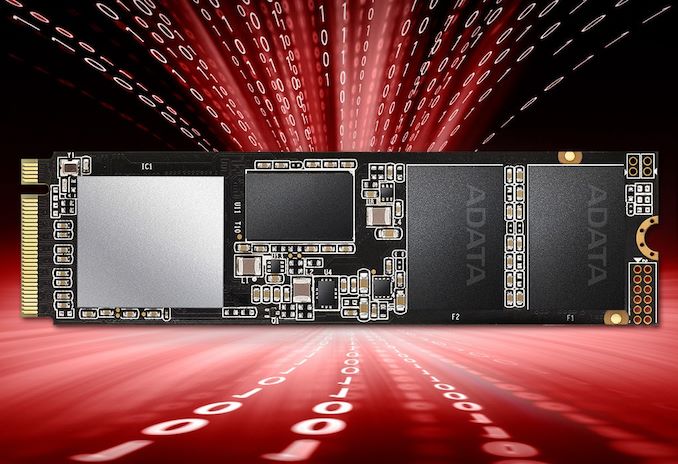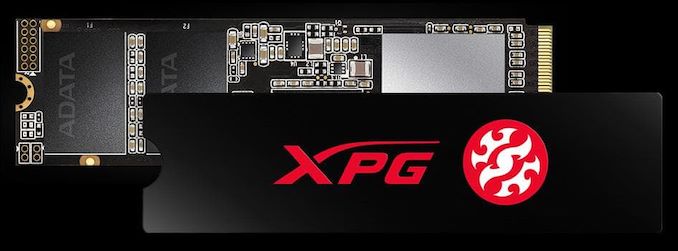ADATA Expands XPG SX8200 Pro Range with 2 TB Model
by Anton Shilov on August 12, 2019 6:45 PM EST
Over the past few months we have seen a number of companies announcing high-end 2 TB PCIe 4.0 x4 M.2-2280 SSDs, which was not particularly surprising given positioning of these drives as well as expected lonf lifecycle on the market. What is a bit more surprising is that some manufacturers are also expanding their existing product lineups with 2 TB SSDs as NAND prices continue to fall. One of such companies is ADATA, which has just released a 2 TB flavor of its XPG SX8200 Pro.
ADATA’s XPG SX8200 Pro is a version of the company’s Gammix S11 Pro without an aluminum heat spreader, which ensures compatibility with laptops. Both drives come in the M.2-2280 form-factor and feature a PCIe 3.0 x4 interface, they are based on Silicon Motion’s SM2262EN controller (eight NAND channels, four ARM Cortex-R5 cores, NVMe 1.3, LDPC ECC, RAID engine, etc.) accompanied by Micron’s 3D TLC NAND. Previously, these drives only featured 256 GB, 512 GB, and 1 TB configurations, but recently ADATA expanded the family with a 2 TB model.
As for performance, the manufacturer claims that the top-of-the-range XPG SX8200 Pro 2 TB drive offers up to 3.5 GB/s sequential read speed and up to 3 GB/s sequential write speed when pSLC caching is used (data based on CDM benchmark), as well as up to 360K random read/write 4K IOPS. The drive is rated for 1280 TB over a 5-year warranty period.
| ADATA XPG SX8200 Pro Specifications | ||||
| Capacity | 256 GB | 512 GB | 1 TB | 2 TB |
| Model Number | ASX8200PNP-256GT-C | ASX8200PNP-512GT-C | ASX8200PNP-1TT-C | ASX8200PNP-2TT-C |
| Controller | Silicon Motion SM2262EN | |||
| NAND Flash | IMFT 3D TLC NAND | |||
| Form-Factor, Interface | M.2-2280, PCIe 3.0 x4, NVMe 1.3 | |||
| Sequential Read | 3500 MB/s | |||
| Sequential Write | 1200 MB/s | 2300 MB/s | 3000 MB/s | |
| Random Read IOPS | 220K IOPS | 390K IOPS | 360K IOPS | |
| Random Write IOPS | 290K IOPS | 380K IOPS | 360K IOPS | |
| Pseudo-SLC Caching | Supported | |||
| DRAM Buffer | Yes, capacity unknown | |||
| TCG Opal Encryption | No | |||
| Power Management | DevSleep, Slumber (0.14 W). | |||
| Warranty | 5 years | |||
| MTBF | 2,000,000 hours | |||
| TBW | 160 TB | 320 TB | 640 TB | 1280 TB |
| Additional Information | Link | |||
ADATA’s 2 TB XPG SX8200 Pro is already available in the US for $289.99, in select European countries (from eBay) for about €306 ~ €308, and in Japan for ¥36,680.
Related Reading:











19 Comments
View All Comments
Charlie22911 - Tuesday, August 13, 2019 - link
I want a 4TB NVME drive so bad, I’d love to get rid of my external spinning rust. I don’t even mind paying a premium for it, just give me the option.Greg100 - Tuesday, August 13, 2019 - link
Here you are......but why bother 4TB NVMe?
The cheapest NVMe per TB is:
Western Digital Ultrastar DC SN630 - 7.68TB
In Germany you can buy it for:
€ 978,23 - Mindfactory
€ 978,24 - Compuland
€ 978,25 - VibuOnline
€ 978,26 - DriveCity
€ 978,28 - Klarsicht IT
4TB SSDs are more expensive per TB than above 7.68 NVMe SSD.
If you find something cheaper let me know.
Greg100 - Tuesday, August 13, 2019 - link
You also need U.2 to M.2 cable from Intel # J15713-001, if you do not have MB with U.2 port.Greg100 - Tuesday, August 13, 2019 - link
Prices include 19% tax (VAT).Greg100 - Tuesday, August 13, 2019 - link
It’s also cheaper per TB than Samsung SSD 860 EVO 4TB SATA SSD!!!€ 591,75 - Mindfactory
€ 591,76 - Compuland
€ 591,77 - VibuOnline
€ 591,78 - DriveCity
Shame on you Samsung!
croc - Wednesday, August 14, 2019 - link
You might also want to mention that this drive is a 2.5 inch form factor.OTOH, imagine four of these in a 1.0 raid array using the Highpoint SSD7110 raid controller.... And up to a total of 16...
Plus up to a 6TB raid of nvme m.2 2280 drives. For those that feel the need for more speed (face it, this drive sucks at write performance...) you can also/or boot from this array in raid 0, 1 or 5 configurations.
Anyway, great post.
Greg100 - Wednesday, August 14, 2019 - link
2.5 inch form factor is always better, because you can place SSDs anywhere on the case, so you can improve the cooling conditions of SSDs.As for the faster drive, my favorite is:
Micron 9300 PRO 15.36TB, U.2 SSD
3500 MB/s (R/W)
€ 2579 (Xitra - Germany) for 15.36TB behemoth!
Luckz - Monday, December 2, 2019 - link
Rocket have a 4TB now. E12S though with halved RAM.WarthogARJ - Thursday, February 27, 2020 - link
I don't think this was a very carefully researched posting: it gives you LESS information than a 2 minute Google search would turn up.For instance the vacuum on information on the DRAM ("capacity unknown"), and the pSLC Cache ("Supported").
Just looking at past reviews by Anandtech itself would give you more information.
And a lot of what it says is wrong, or at least misguided:
(1) "ADATA’s XPG SX8200 Pro is a version of the company’s Gammix S11 Pro without an aluminum heat spreader, which ensures compatibility with laptops"
Actually, no. The Gammix S11 Pro is a version of the SX8200.
And as more knowledgeable reviewers have mentioned, all of the M.2 format can suffer from thermal throttling, so anyone using this SSD should either add a heat exchanger (not actually a heat "spreader") or make sure it's got a fan's output directed at it.
(2) "What is a bit more surprising is that some manufacturers are also expanding their existing product lineups with 2 TB SSDs as NAND prices continue to fall"....
Eh? Hmmmmmm....so Mr. Shilov, what's the logic here?
It's pretty obvious that as NAND prices fall, it makes larger SSD's more attractive.
The main point to look at is $/GB.
As one can see from reading Anandtech's own reviews (by other Reviewer's than Mr. Shilov), you can see that it you want >= 2TB of storeage space available, in terms of internal and external drives, you're MUCH better with as much of it on SSD (Sata or PCIe) as you can afford.
And for the 2TB value, even if a lot of laptops don't have this available internally, what percentage of laptop users with machines younger than 5 years old have LESS than 2TB capacity: internal plus external?
This idea about SSD drives was that even older models could benefit from upgrading to one.
And about 3 years ago, anything > 512GB was quite expensive, but now, there's a huge number of very cheap 1TB models available: dirt cheap.
Cheaper than a 1TB HDD was 6-7 years ago in fact.
And you can get a 2TB model for not much extra.
In many cases, if you look at the cost of putting a 1TB SSD inside, and a 1TB USD HD externally, you spend LESS getting a 2 TB model.
Do the math, and you'll see.
So what would be nice if someone else at Anandtech did a few more tests on 2TB models, and generate real data. And don't write stuff like this.